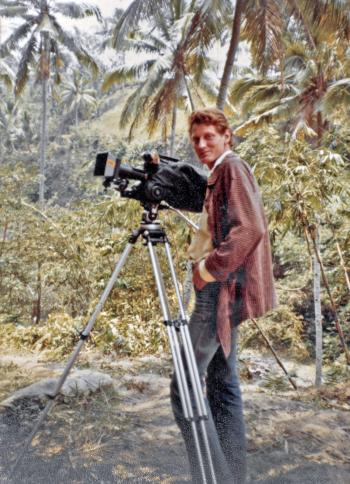The searcher who cared and shared
Through special visas Sandiago Uno wants access to the wallets of ‘digital nomads’, Gen Zedders with laptops in their backpacks and access to flawless Wi-Fi.
The Tourism Minister thinks that once among Bali’s palms and paddy they’ll spend their overseas earnings on local services. Whether they’ll leave any positive legacy like earlier visitors is another matter.
Before Bali was transformed from a relaxed, magical and accepting culture to a money machine driven by outside investors, footloose creatives had embraced the island’s rich spirituality. One was Australian John Darling, a young man with a fine education and assured career.
Despite these advantages he didn’t have much idea of what he wanted to do and where to go. His university lecturer reportedly told him he’d make ‘a far greater contribution by increasing Australian understanding of Indonesia through living and researching Bali and other areas of the archipelago’.
As so often happens to open-minded seekers, the purpose found him and it came with a rare culture, an exotic environment and a cine camera.
Now thanks to admirers of his thoughtful films we have a tribute to a contemplator who came to know Bali better than most, accepted what he’d found, and sought to share.
John Darling, an Australian filmmaker in Bali, is a collection of 21 essays assembled by Australasian academics Graeme MacRae and Anton Lucas. There are photos and a few poems:
‘In the mountains / I saw a river/ running rapid
For Buddha /a deep pool / ripples / out from centre
In a quiet place / a fat frog/ croaks content
Trapping his needs / from a flying world.
John seemed a most unlikely member of the Bali Lovers League. He was born in Melbourne in 1946 and raised among the elite. His father James Darling was headmaster at Geelong Grammar, one of Australia’s most prestigious schools.
His son’s paved path was heading straight to an academic career, but capricious fate added turns. After uni John lost his way; mates suggested Indonesia, a puzzling land to most Australians.
He disembarked in Jakarta, slowly headed east, and then into Bali where serendipity intervened.
According to the book revelation came one dawn in a paddy where he met I Gusti Nyoman Lempad the famous Balinese sculptor and artist, then aged 108. He squatted and smoked with a restive Aussie 84 years younger, ‘seeking a place in which to develop my obscure talents.’
These required celluloid and a mate with technical knowledge. That was to be Lorne Blair, a filmmaker from the UK who became internationally famous for his TV series Ring of Fire, an Indonesian Odyssey made with his brother Lawrence.
Lempad died in 1978 and so began a prolonged set of elaborate funeral rituals which the two outsiders filmed. Because John was an accepted member of the community and by now could speak Balinese he had open access to all preparations for the cremation.
Forty-three years later and online, Lempad of Bali has lost little across the decades. It could have been an ethnographic exercise of limited interest outside social anthropology courses, but it was made as a story of interest to all.
That ability to make serious cinema accessible helped the producers win the Documentary Award at the Asian Film Festival, and set John’s future not just as a director but also lecturer, writer and poet.
I worked with him on one film and found him introspective – yet engaging. Some saw him as ‘shy and very cerebral … a latter-day Romantic poet.’
Others report a funny man with ‘good manners’, and a ‘dashing dandyish figure.’ Toby Miller, a student who became a friend and is now teaches cultural-studies writes;
‘Despite his fame Johnny needed a lot of care – and was himself full of caring love. He was vulnerable and strong in equal parts.’
John’s later films shown on mainstream television internationally included Bali Hash, Slow Boat from Surabaya, Master of the Shadow and Bali Triptych, described as
Equally memorable was Below the Wind telling of the Sama Bajo, the sea nomads of South Sulawesi.
John’s final work when he was sick with a genetic disease that took his life in 2012 was The Healing of Bali after the 2002 Kuta night club blasts which killed 202. There was a rush of journalists to the island. Other camera crews focused on the terrorists. John’s production concentrates on the survivors and how they are coping with the horror.
There’s no foreign voice-over. The people speak for themselves. The grief is raw. The viewer is there.
David Hanan, an Australian film-studies lecturer writes that a major theme of the film ‘is the lack of discrimination, indeed the underlying warmth of the religiously tolerant Balinese people – including those most impacted by the events – towards local Muslim residents.’
Reviewer David Reeve concluded: ‘This film is about the healing of Indonesia too, and indeed the world. It is expertly crafted and I pay tribute to the power of the film and its expertise.’
His widow and co-producer Sara offers a moving account of the shoot and this tribute:
‘John was a peaceful man who promoted harmony. He related to everyone, from priests to farmers. His films have helped make Indonesia accessible to the world, particularly Australians who so frequently distrust and misunderstand their northern neighbour.’
Digital nomads need this worthy book to appreciate their second home. So do all spellbound by Bali, striving - like John – to see if they fit. And if so, how and why.
Disclosure: The author is one of the contributors.
First published in Indonesia Expat Ed 292 January 2023: https://web.facebook.com/photo/?fbid=659611166026631&set=pb.100059332612855.-2207520000.



No comments:
Post a Comment